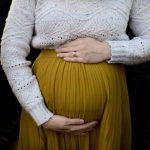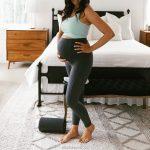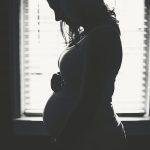Maternity Clothes Size Chart And Sizing Guide
Maternity outfits sizes are the same as regular ones, which means you’ll be a maternity medium if you regularly wear a size medium.
It doesn’t imply your waist is still the same while you’re pregnant, but clothing businesses maintain the sizing consistent to make maternity clothes purchasing easier. Of course, your body will undergo some changes. Learn all about body sizes and their effect on size charts here
Also, plus-size maternity outfits have the exact sizing as regular maternity outfits. However, plus-size garment sizing varies by shop, like all fashion, so take your measurements and check the maternity clothes chart before purchasing.
Maternity Clothes Size Chart
When shopping for your cute maternity clothes, it is vital to use a size chart and similar size guides (maternity size charts). A professional maternity clothes chart will assist you to get your ideal maternity clothes sizes. It also aids in providing accurate hip, waist, regular size, cup size, and bust size measurements among others.
Here is a general maternity clothes chart for reference. Each manufacturer will have their custom charts based on their designs, so please use the manufacturer’s chart at the time of shopping.
| SIZES | Waist | Bust | Hips | ||||||
| INCHES | CM | INCHES | CM | INCHES | CM | ||||
| CANADA-US | EUROPE | UK | |||||||
| XS | 2-4 | 34-36 | 6 | 28-30 | 71 – 76 | 34 – 36 | 86 – 91 | 37 – 39 | 93 – 99 |
| S | 4-6 | 36-38 | 8 | 30-32 | 76 – 81 | 36 – 38 | 91- 96 | 39 – 41 | 99 – 104 |
| M | 8-10 | 38-40 | 10 | 32-34 | 81 – 86 | 38 – 40 | 97 – 102 | 41- 43 | 104- 109 |
| L | 12-14 | 40-42 | 12 | 34-36 | 86 – 91 | 40 – 42 | 102 – 107 | 43 – 45 | 109 – 114 |
| XL | 14-16 | 42-44 | 14 | 36-38 | 91- 96 | 42 – 44 | 107 – 112 | 45 – 47 | 114 – 119 |
Tops and Bottoms Charts
Size (pre-pregnancy) | Shirts & Tops | Pants & Bottoms | Maternity Size | ||
| Chest | Hips | ||||
| INCHES | CM | INCHES | CM | ||
| XS (0-2) | 34-35 | 86-89 | 36-37 | 91-94 | XS |
| S (4-6) | 36-37 | 91-94 | 38-39 | 97-99 | S |
| M (8-10) | 38-39 | 97-99 | 40-41 | 102-109 | M |
| L (12-14) | 40-41 | 102-104 | 42-43 | 107-109 | L |
| XL (16-18) | 42-43 | 107-109 | 45-46 | 114-1117 | XL |
| 1X (18-20) | 45-46 | 114-117 | 48-49 | 122-124 | 1X |
| 2X (22-24) | 47-48 | 119-122 | 50-51 | 127-130 | 2X |
| 3XL (26-28) | 49-50 | 124-127 | 52-53 | 132-135 | 3X |
Body Measurements
It’s critical to know what to measure and measure correctly before purchasing any maternity clothing. A tape measure is the most common tool for taking measurements regardless of the product type or maternity items. From maternity coats to maternity pants, a tape measure is the most prominent tool for clothing measurements.
Here is a brief demonstration of how you can go about finding your current measurements and determining your maternity clothes sizing across different types of maternity wear. A complete expert guide on how to measure your body for clothing size you can read here
For maternity bras (maternity bra sizing):
The bust area is the most important measurement you need for bras, and here is how to do it;
Bust measurement
Measure across the widest circumference of your bust, beneath your arms.
Underbust
Measure your chest below your breasts (bra-line)
For tops
You certainly want very nice fitting tops and it takes getting the measurements right. here is how to go about it;
Shoulder
Measure from the broadest point on one shoulder to the widest point on the other.
Bust
Measure across the widest circumference of your bust beneath your arms. For underbust, please measure your chest below your breasts.
For dresses
Dresses are some of the most important maternity wear. Here s a quick guide on taking measurements for dresses;
Shoulder
Measure from the broadest point on one shoulder to the widest point on the other.
Bust
Measure across the widest circumference of your bust beneath your arms. For underbust, please measure your chest below your breasts.
Hips
Measure the most expansive area of your hips.
Thigh
Measure the most expansive area of your thigh.
For pants
Pants are equally essential, please use the below steps to take measurements;
Hip measurement
Measure the broadest area of your hips.
Waist measurement
Measure the widest part of your baby bump.
High Waist
Take the body circumference measurement above the bump.
Low Waist
Measure the body circumference below the bump.
Thigh
Measure the most expansive area of your thigh.
Inseam
Measure the length from the top of your inner thigh to the bottom of your ankle
When is the Right Time to Shop for Maternity Clothes?
Women expecting their first child are generally ready to start wearing maternity clothes at around sixteen – twenty weeks in the second trimester. However, everyone is different, and there is a range of circumstances that might influence when you will need to purchase maternity clothing.
While some women experience stretching and extra weight immediately, others are fortunate enough to wear their usual clothes for extended periods.
Therefore, there is no mandatory moment when you should start wearing maternity clothes throughout your pregnancy. When you feel uncomfortable in your regular attire, it’s time to shop for something new.
Signs that it’s time to buy maternity clothes
Here are a couple of signs to look out for:
- Your trousers won’t button: Even if this is your first pregnancy, your pants may begin to feel uncomfortable quite early on. It’s time to put your pre-pregnancy pants away when they become uncomfortable. While pregnancy is a precious miracle, it also comes with its share of discomforts, and there’s no reason to add to those discomforts by wearing jeans that no longer fit.
- Your belly protrudes from behind your shirt: It’s probably time to invest in some maternity clothes if your stomach is popping out from under your shirt.
- Your bra is too tight for you: A correctly fitting bra is necessary for comfort and breast health. Consider purchasing a pregnancy or nursing bra if your current bras are too tight.
In most cases, you’ll need to move to maternity clothing sooner in your second and subsequent pregnancies. This is because your abdominal muscles have already been stretched at least once, causing your baby bulge to appear earlier. You may require maternity clothes towards the middle and end of your first trimester, about 8-12 weeks, with your second pregnancy.
Common Types of Maternity Clothes
There are many stylish maternity outfits on the market today. During your pregnancy, keep in mind the weather and the changing seasons.
Here are a few suggestions;
Maxi skirts and dresses
These types of maternity clothes are roomier than most other designs, usually giving adequate covering. They’re airy and adaptable, making them ideal for the summer. Some may even have a breastfeeding-friendly top section to make things easier for you when the baby arrives.
Maternity Flowy shirts
Most maternity clothes are already on the loose side around the belly. Investing in a few simple pieces, such as black, white, and grey will allow you to wear them with various outfits. They’ll usually feature an empire waist to give them form and enhance your expanding baby belly.
Maternity Leggings
Leggings are popular for being pretty comfy. You may wear them with a dress or beneath a long, flowing T-shirt and be warm in no time. For extra support, most pregnancy leggings will have a high waist.
Maternity jeans
Some maternity jeans have a belly band, while others have elastic panels on the sides. Both are useful, but those with flexible sides are more modest and may be used after your kid is born.
Maternity Tank Tops
Conclusion on maternity clothes size charts
Planning when, where, and how to buy your maternity wear is essential. Putting together your new maternity wardrobe should indeed be a pleasurable and stress-free experience.
While there is no one-size-fits-all solution for when you’ll need to transition to maternity wear, planning out what you’ll need and how you’ll put it all together is a beautiful place to start when it comes to being ready to shop for maternity clothes. In the meantime, a belly band and other loose-fitting shirts can do the trick!
Please ask any questions you might have, and also, it would be nice to hear about your pregnancy experiences.
Pictures in this maternity clothing size post by Nicole Herrero on Unsplash
Related maternity and nursing size charts
- Breast Size During Pregnancy: What to Expect
- Gap Women Size Chart with Easy to Use Size Conversion and Fitting
- Maternity Clothes Size Chart And Sizing Guide
- Maternity Pants Size Chart And Fitting Guide
- Breast shield Sizing Guide – Choose The Right Size Nipple Shield
- Maternity Legging Size Chart And Fitting Guide
- Breastfeeding Bra Size Chart – find your nursing bra size
- Maternity Tank Top Size Chart And Sizing Guide









